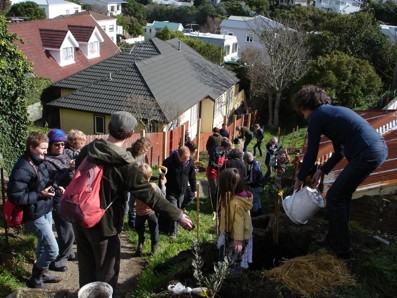- Home
- About
- Local groups
- Community
- News
- Resources
- Offer Support
- Contact us
"A community orchard is taking off in Brooklyn" article
This article was written by Hannah Zwartz and was first published on 28 August 2010 in the Dominion Post. Thanks Hannah for letting us republish it.
In a few years’ time, Brooklyn children walking home from school will be able to pick apples and pears from their own community orchard. The orchard, officially opened last weekend, runs along both sides of a public walkway from the end of Harrison Street down to McKinley Terrace.

50-odd people turned out to plant trees on Sunday August 22 along with sun, flowers, and music from local ukelele band the Flukes. It was the culmination of two years hard work for Mel Beirne and Kelda Hains of Transition Town Brooklyn’s food and gardening group. The pair negotiated with council to lease the land (for $1 per year) and fundraised over $5,000 for trees, steps, posts and compost by selling garden produce, running film evenings and sourcing donations from local businesses.
Chef and co-owner of Nikau café, Hains has a special interest in growing food. She loves cooking with older style fruits not readily available in supermarkets like quinces, damsons and cooking apples. But the orchard project is not only about feeding the hungry masses, she says. “It’s an educational resource as well as a food resource.”
Workshops on tree care – pruning, training and companion planting – are part of the group’s future plans. People will be able to get knowledge, get inspired and go home to plant stuff in their own gardens, says Beirne. “And we’ll be able to show children, this is where an apple comes from.”
For her, the orchard has a third-fold benefit of growing community as well as food. “It’s a space for people to gather as a community.” (To this end, a picnic table is also on the wishlist.)
The trees were chosen with help from Sarah Frater of Edible Gardens, who ran a workshop with the Transition Towns group. “Brooklyn being an old suburb, a lot of people have moved into places with old fruit trees, and inherited the trees, but didn’t know what to do with them,” says Beirne. Frater fielded their questions, and made planting recommendations to suit the steeply sloping site.
A windy area at the top of the walkway is planted in feijoas, while apple and pear trees further down are on rootstock chosen to suit the heavy clay soil. To make the most of the long, narrow site, the pears will be espaliered - trained to grow with horizontal arms tied along supporting wires strung between large posts. There are sunny terraces for strawberries, cape gooseberries and a tamarillo from the garden of Celia Wade-Brown, who has supported the project through the council process. Peaches, peacherines, quinces, almonds and several types of plums have been timed to ripen progressively. Beirne’s favourite is the Bramley cooking apple, which recently celebrated its 200th anniversary, having been discovered as a chance seedling in 1809.
It’s not all about fruit – the trees will be underplanted with comfrey to mine nutrients from the subsoil, and flowers like borage and alyssum to attract beneficial insects.
Because of the clay soil, generous holes were dug with a bucketful of `potion’, including lime, trace elements and microbial inoculation, placed at the bottom of each hole. Sturdy stakes and windbreak protect the trees from gales while bricks tied to the roots make them difficult to steal or vandalise.
Beirne believes the orchard is the first of its kind in Wellington- though hopefully not the last. “There’s a group from Hataitai in consultation with council at the moment…”
Brooklyn’s Planting Potion:
- One bucket of compost
- One scoop of rock dust (crushed rock with trace elements like molybdenum, zinc and cobalt, essential to plants in tiny quantities)
- One handful of lime (to sweeten the clay soil)
- One handful of forest floor litter (rich in microbial life, to break down organic matter into forms that roots can absorb).
Recent comments
16 weeks 5 days ago
39 weeks 5 hours ago
42 weeks 2 days ago
46 weeks 12 hours ago
49 weeks 6 days ago
1 year 3 days ago
1 year 3 days ago
1 year 12 weeks ago
1 year 29 weeks ago
1 year 41 weeks ago